AI Ticket Triage | Benefits, Tools & Implementation
Ticket triage is one of the most widely adopted use cases for AI-powered workflows. Huge numbers of teams have already adopted some form of AI processing on their incoming tickets for a range of internal and external support functions.
However, there are a few distinct ways we can go about this, from AI tools within dedicated ticketing and support platforms to more customized solutions.
Today, we’re diving deep into AI ticket triage, including what to look for in solutions, and how we can build AI-powered workflows for handling incoming tickets with Budibase.
Specifically, we’ll be covering:
- What is AI ticket triage?
- Why do we need AI ticket triage?
- What to look for in an AI triage tool
- How to build AI ticket triage tools in Budibase
Let’s start with the basics.
What is AI ticket triage?
AI ticket triage means using artificial intelligence tools to perform initial categorization, prioritization, and other kinds of analysis on incoming requests and issues.
More concretely, the idea here is to utilize natural language processing alongside defined business rules to determine the type and severity of the ticket.
This is increasingly prevalent in a range of workflows within IT, HR, finance, customer service, and other teams.
One key problem that this solves is the fact that tickets often involve some amount of qualitative information. Typically, this has meant that we need human service agents to read and analyze submissions manually.
By contrast, AI offers us a powerful way to automate more cognitive tasks that would otherwise require human input.
Ultimately, the goal is to route incoming tickets to the appropriate queues or colleagues, using defined rules to determine what they relate to and how urgent they are.
This might be carried out as a standalone automation or as an action within a wider automation rule.
Why do we need AI ticket triage?
With a better understanding of what AI ticket triage is, we can move on to considering some of the concrete benefits that we can achieve by implementing this.
We already know that the alternative is having human agents manually review and route incoming tickets.
As you might expect, this process is time-consuming, as well as being error-prone and often inconsistent, especially when we’re dealing with high ticket volumes.
In light of this, some of the key drivers for the growing adoption of AI triage include:
- Faster response times - AI can analyze and route tickets in real time, leading to faster resolutions.
- Improved accuracy - LLMs can leverage historical data to classify tickets more consistently than humans, minimizing misrouted or miscategorized requests.
- Better prioritization - AI can assess urgency based on ticket content, business rules, sentiment, and context, ensuring that critical issues are addressed first.
- Reduced workload - Automating repetitive triage tasks allows support teams to focus on solving complex issues instead of sorting and tagging tickets.
- Data-driven insights - AI triage systems can identify trends and recurring issues, helping organizations improve root-cause analysis and knowledge base content.
Notably, these benefits will be felt by support teams themselves as well as service users and the wider organization. Support teams can spend less time on menial tasks, service users have their issues resolved faster, and the wider ticketing workflow incurs fewer resources.
What to look for in an AI triage tool
Knowing what the benefits of AI triage are, we can also think about some of the key decision points we’ll encounter when considering specific platforms.
As with any software procurement decision, the return on investment we’ll see is contingent on us choosing the platform that’s right for us across a range of technical, operational, and financial factors.
Earlier, we hinted at the fact that solutions can come in a variety of forms, from triage bots within dedicated support and ticketing platforms to more granular, custom tools.
These will determine our ability to achieve ROI from AI triage, including factors such as its long-term effectiveness and scalability.
Some of the key decision points we’ll encounter include:
- Integration and compatibility - How the tool connects with your existing ITSM or helpdesk systems.
- Accuracy and model training - The AI’s ability to learn from ticket data and improve over time.
- Customizability - The flexibility to adapt categories, routing logic, and workflows.
- Transparency and explainability - The clarity of routing and prioritization decisions.
- Scalability and performance - The capacity to handle growth and peak ticket volumes.
- Security and compliance - Alignment with standards such as ISO 27001, SOC 2, and GDPR.
- Ease of deployment and maintenance - The setup effort and ongoing management requirements.
- Cost and ROI - The balance between investment, efficiency gains, and service improvements.
- Model flexibility and control - The level of choice, tuning, and oversight over AI models.
- Digital sovereignty - The degree of control over data, models, and processing locations.
- Hosting options - The availability of on-prem, private, or regional cloud deployments.
- Vendor lock-in risk - The ease of migrating data and models to other platforms.
Notably, the specific balance of these will vary from one team to the next. For instance, large, highly regulated organizations will often be more concerned with model selection or digital sovereignty.
Smaller teams might be more inclined to prioritize other factors like ease of deployment. As such, the key thing is to have a clear idea of your own requirements, functionally, operationally, and commercially, before assessing specific platforms.
You might also like our round-up of the top open-source AI agent platforms .
How to build AI ticket triage tools in Budibase
To show off how we can build AI triage into ticketing workflows, we’re going to build a simple example in Budibase.
Specifically, we’re going to show off the process of building a ticketing form that will utilize Budibase AI to automatically triage tickets by determining the category and priority of new submissions.
Sign up for a free Budibase account to build along with us.
We’re starting with a simple BudibaseDB table called Tickets. This contains columns called Title, Description, Reproduction Steps, Status, and Created At. Status and Created At will be auto-populated, while the others require user-submitted values.

We’ll be implementing most of the functionality we want to build within the Data section, using Budibase’s built-in AI Column.
Building our ticketing form
The first thing we’re going to do is build a form for submitting new tickets. To do this, we’ll hit Generate and choose the option to create a form.
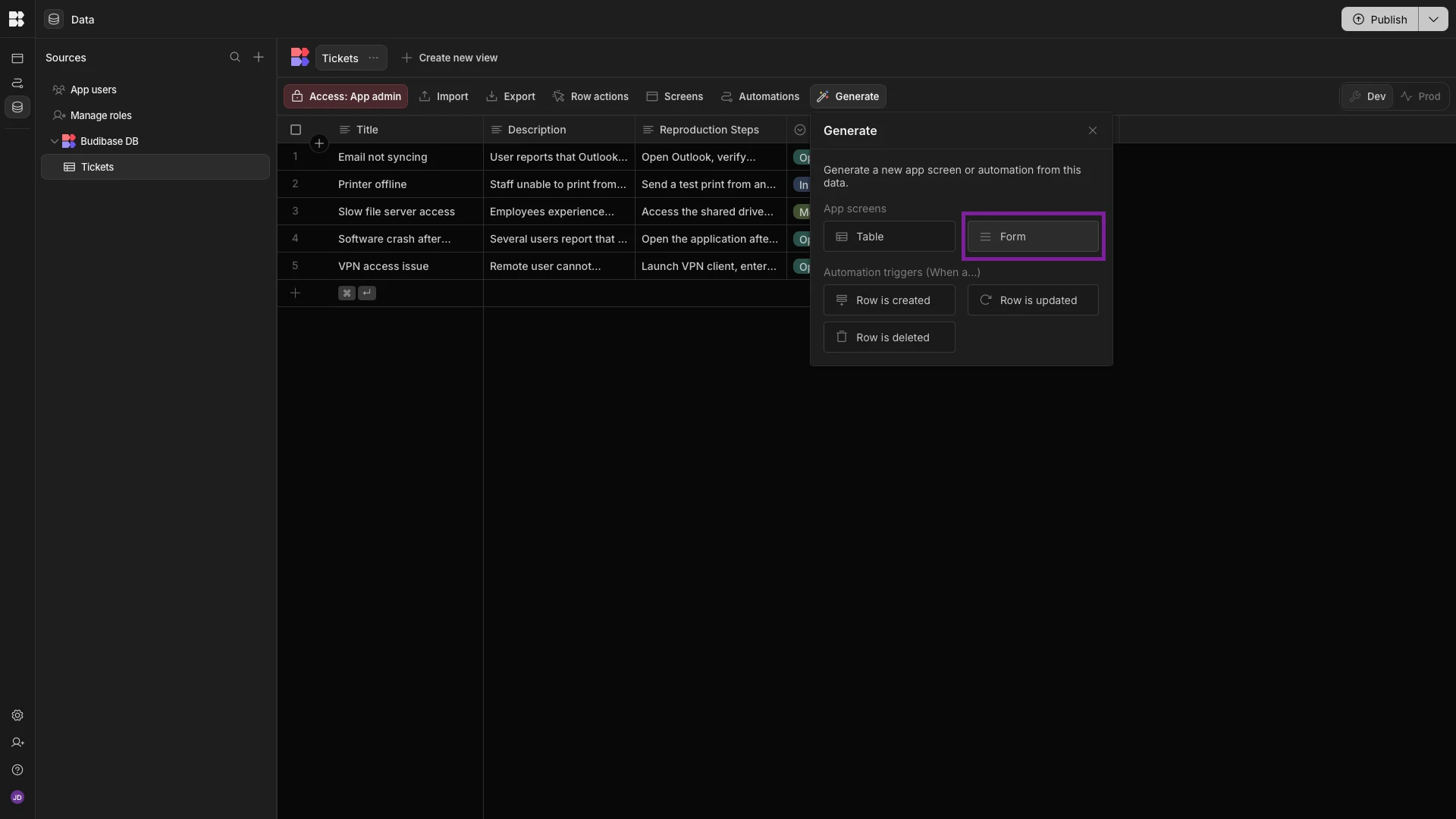
When prompted, we’ll choose the option for a form that creates a new row.

Here’s what this looks like in the Apps section of our Budibase workspace.
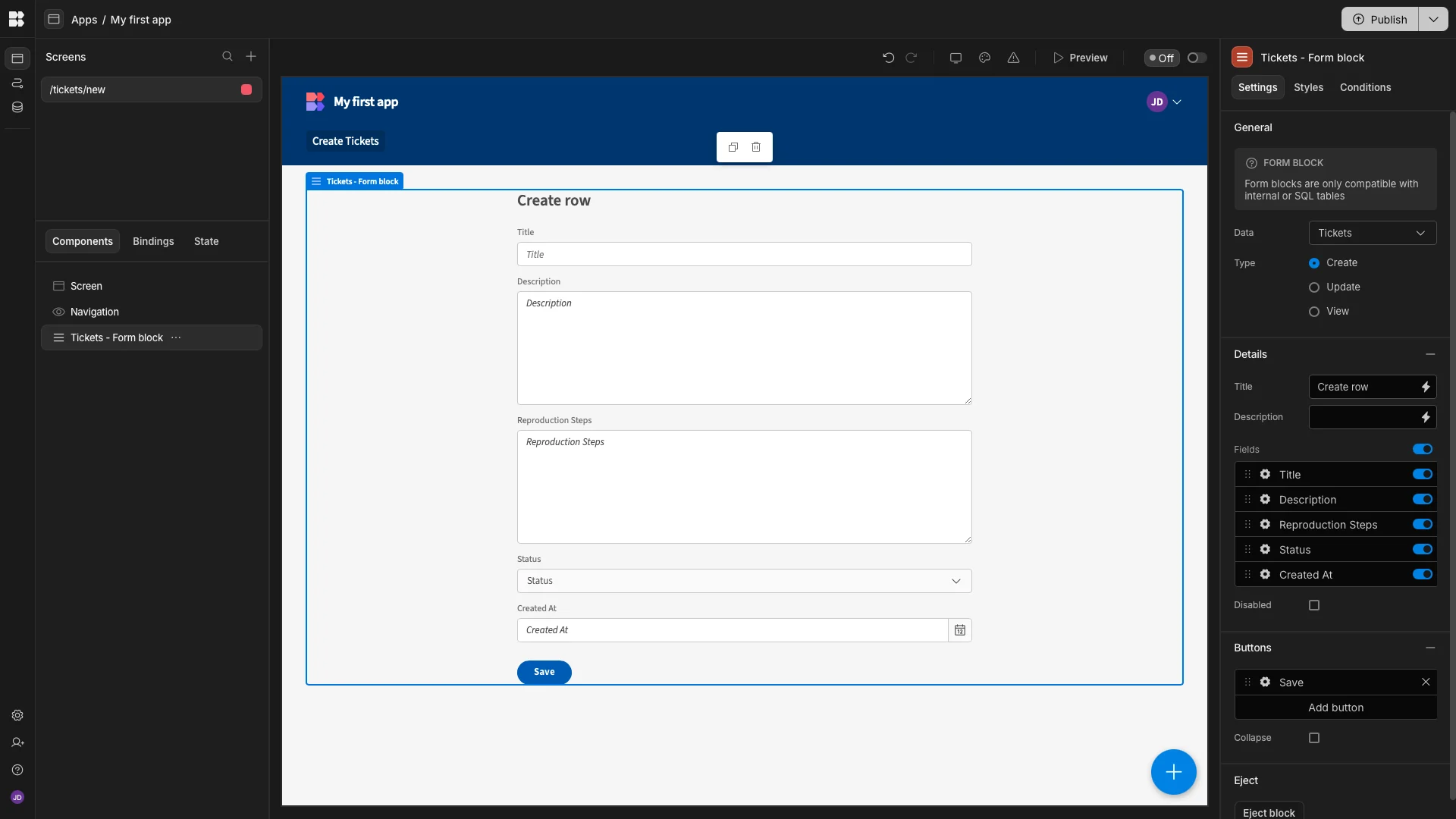
All we’re going to do is make a few minor UX tweaks. Firstly, we’ll use the sliders to deselect the Status and Created At fields, since these will be autopopulated using default values.

We’ll give our form a more descriptive Title, then under Styles, we’ll set our Button Position to Top.
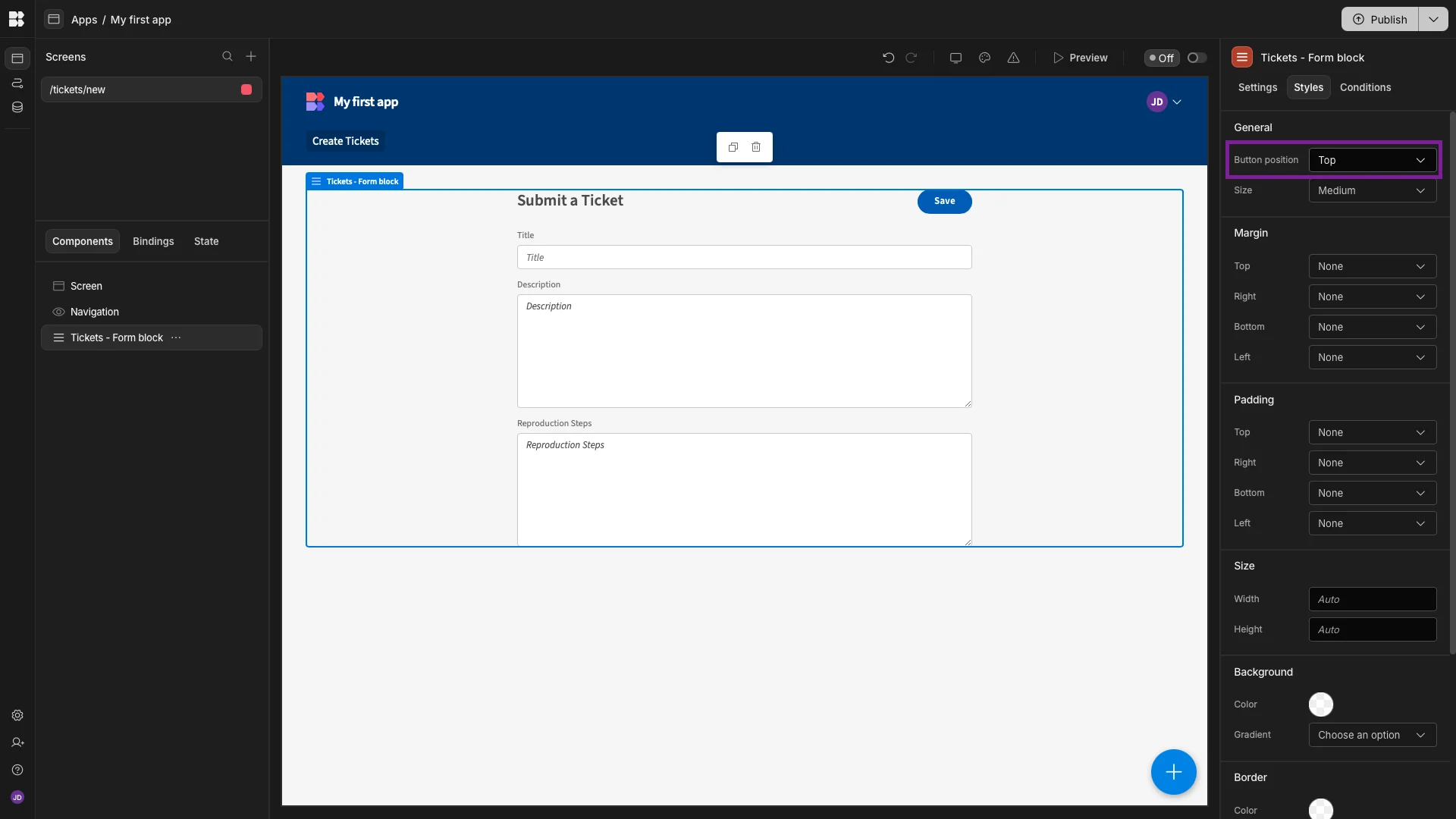
Lastly, we’ll head to Navigation, where we can remove our single nav item and update the Title of our app.

You might also like our guide to building AI forms .
Categorization
Now that our users have a way to submit tickets, we can begin to create our AI triage system. As we said earlier, this will do two things - categorize and prioritize our submissions.
We’re going to start with categorization.
Back in the data section, we’ll start by hitting the + icon to add a new column to our Tickets table.
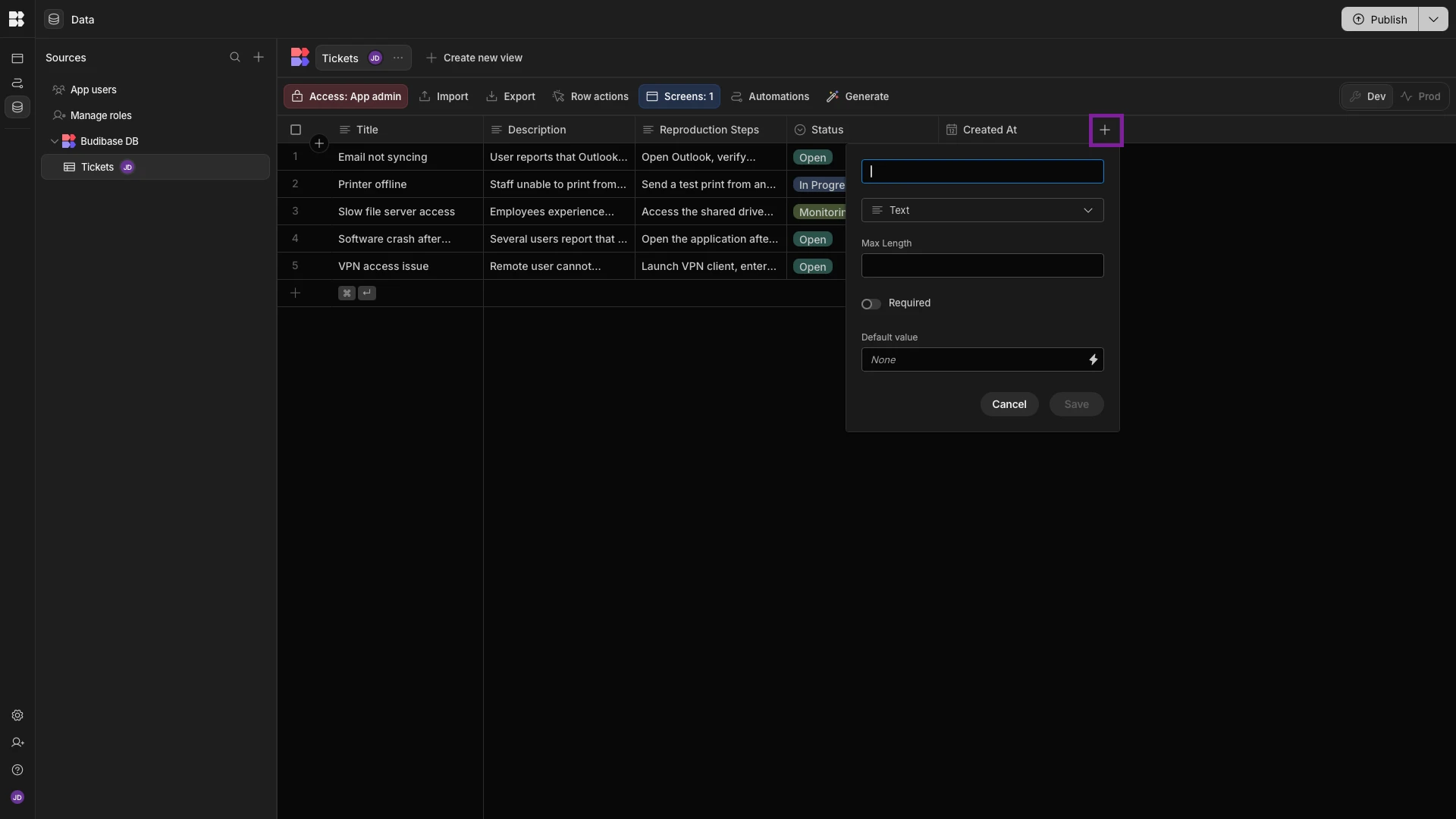
We’ll call this Category and choose AI as our data type.
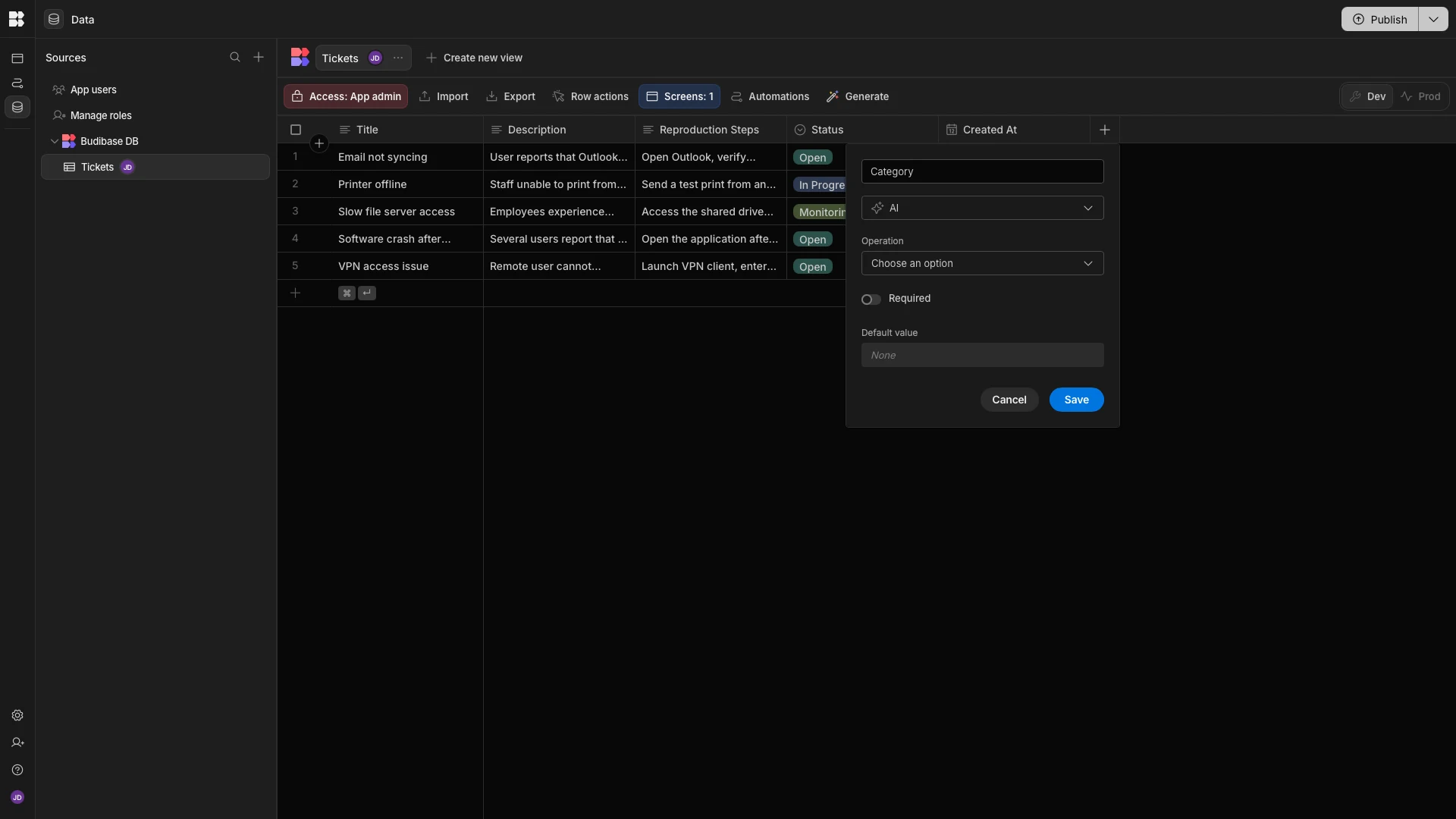
Then we’ll choose Categorise Text as our operation, selecting Title, Description, and Reproduction Steps as our Columns.

We can then enter our possible categories as comma-separated values. Since our demo is an IT ticketing system, we’re using Hardware, Software, Network, Security, and Other`.
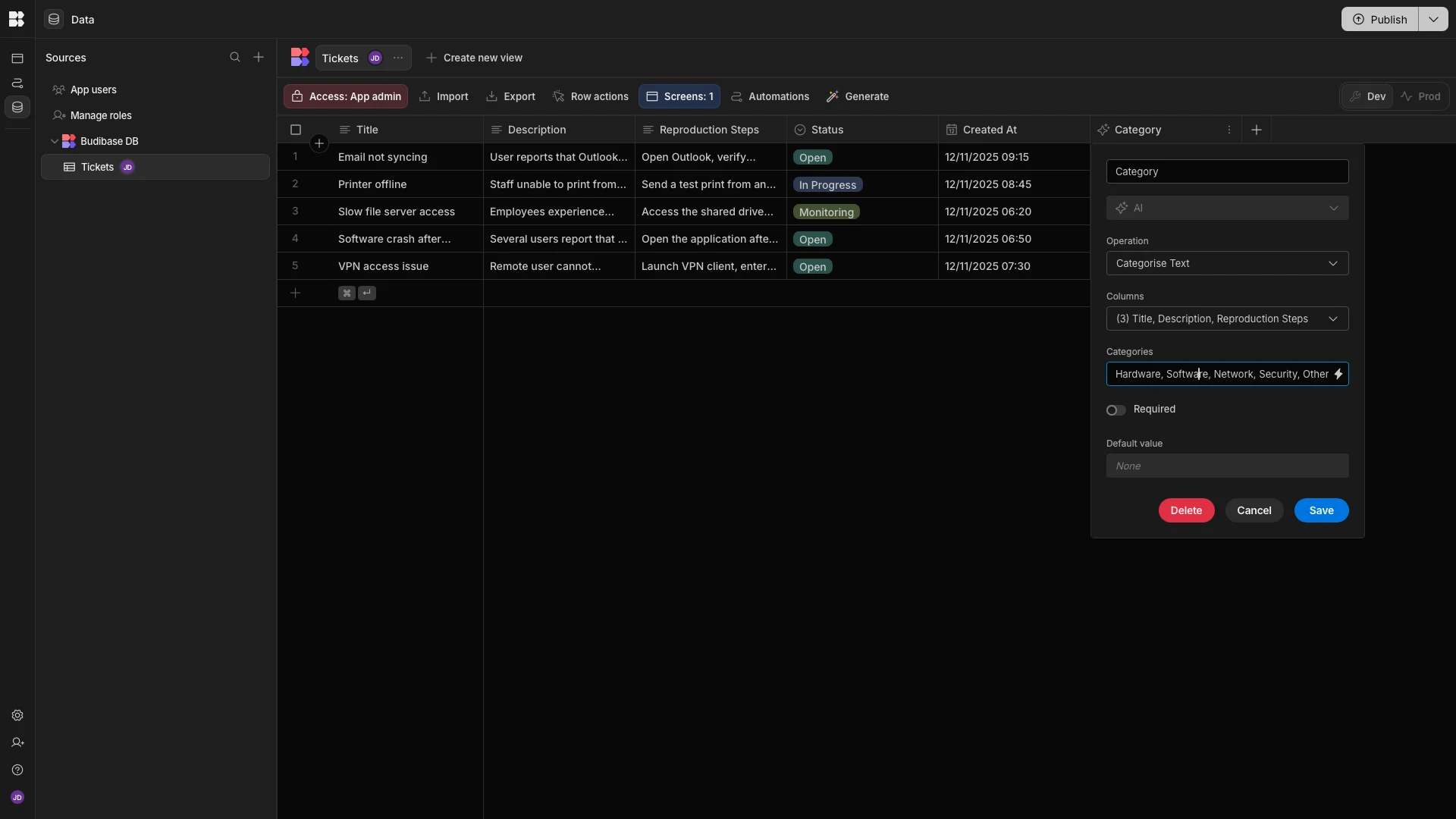
We can test this on our existing row to confirm that it has worked correctly.

Now, all incoming tickets will have the correct Category assigned to them automatically.
Prioritization
Next, we’re going to add logic to use AI to assign a priority to our incoming tickets. This is slightly more complex.
Whereas we can use one of Budibase AI’s built-in operations for categorization, we’ll need to create our own prompt logic for prioritization.
As before, we’ll start by adding a new AI Column. We’ll call this one Priority. This time, though, we’re choosing Prompt as our operation.
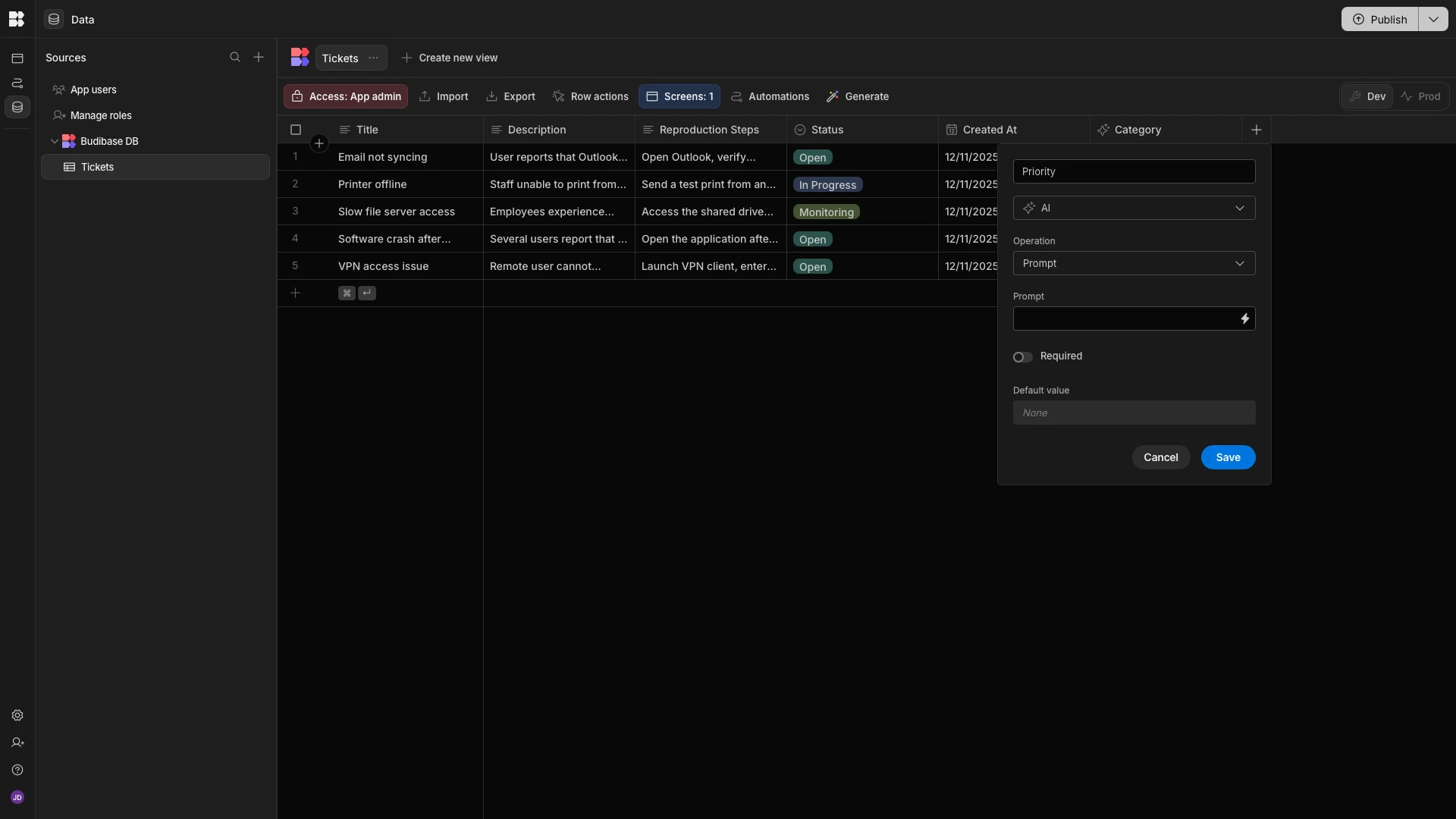
We can hit the lightning bolt icon to open up the bindings modal, where we can write our prompt, including passing values from our database table.
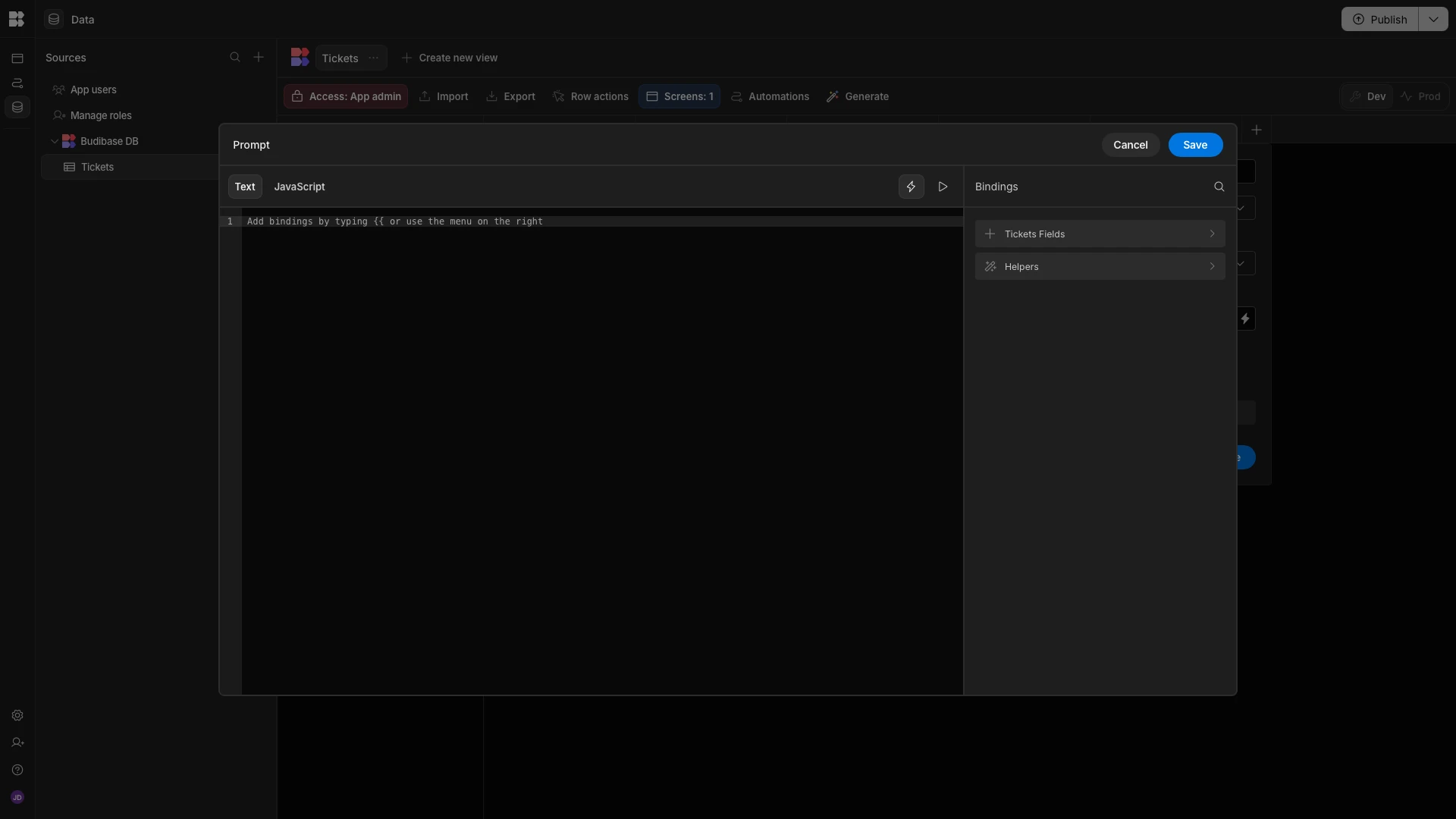
We’ll pass our Title, Description, and Reproduction Steps fields to our AI model for analysis with the following prompt:
1You are an IT service management assistant. Your task is to assign a numerical priority (1–5) to an IT support ticket based on its Title, Description, and Reproduction Steps.
2
3Priority scale and logic:
4
51 – Very Low, minor issue with no operational impact or urgency.
6
72 – Low, small inconvenience or cosmetic issue affecting a single user.
8
93 – Medium, functional issue affecting one or more users but with a workaround available.
10
114 – High, major issue affecting multiple users or an important business service, no immediate workaround.
12
135 – Critical, system-wide outage or severe impact on business-critical operations requiring immediate attention.
14
15Assess the severity, scope, and urgency implied by the text.
16
17Base your judgment only on the provided ticket details.
18
19Respond with only the number that represents the appropriate priority level — no explanation, no extra text.
20
21Ticket:
22
23Title: {{ Title }}
24
25Description: {{ Description }}
26
27Reproduction Steps: {{ Reproduction Steps }}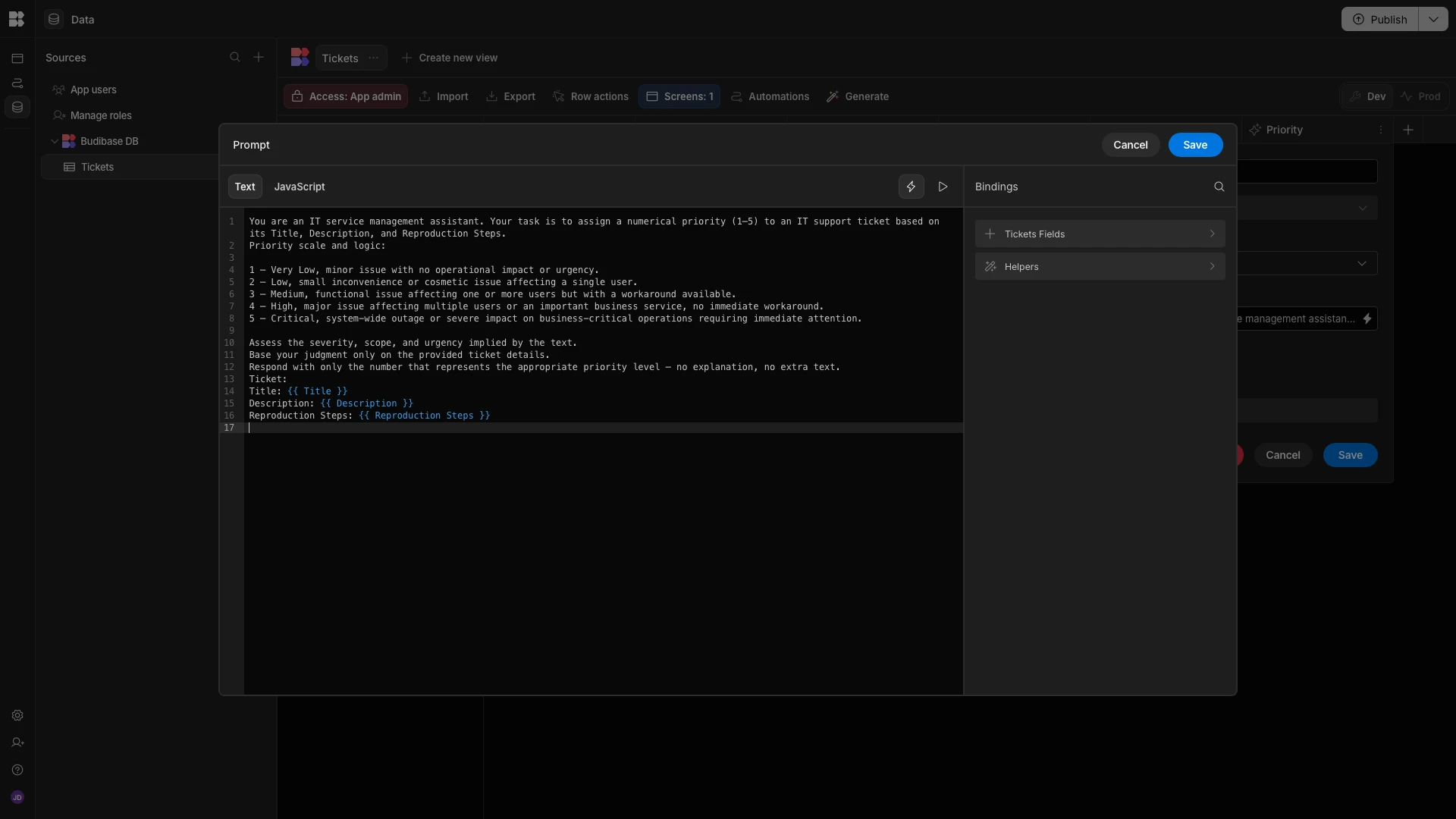
Again, we can test this out on our existing rows.
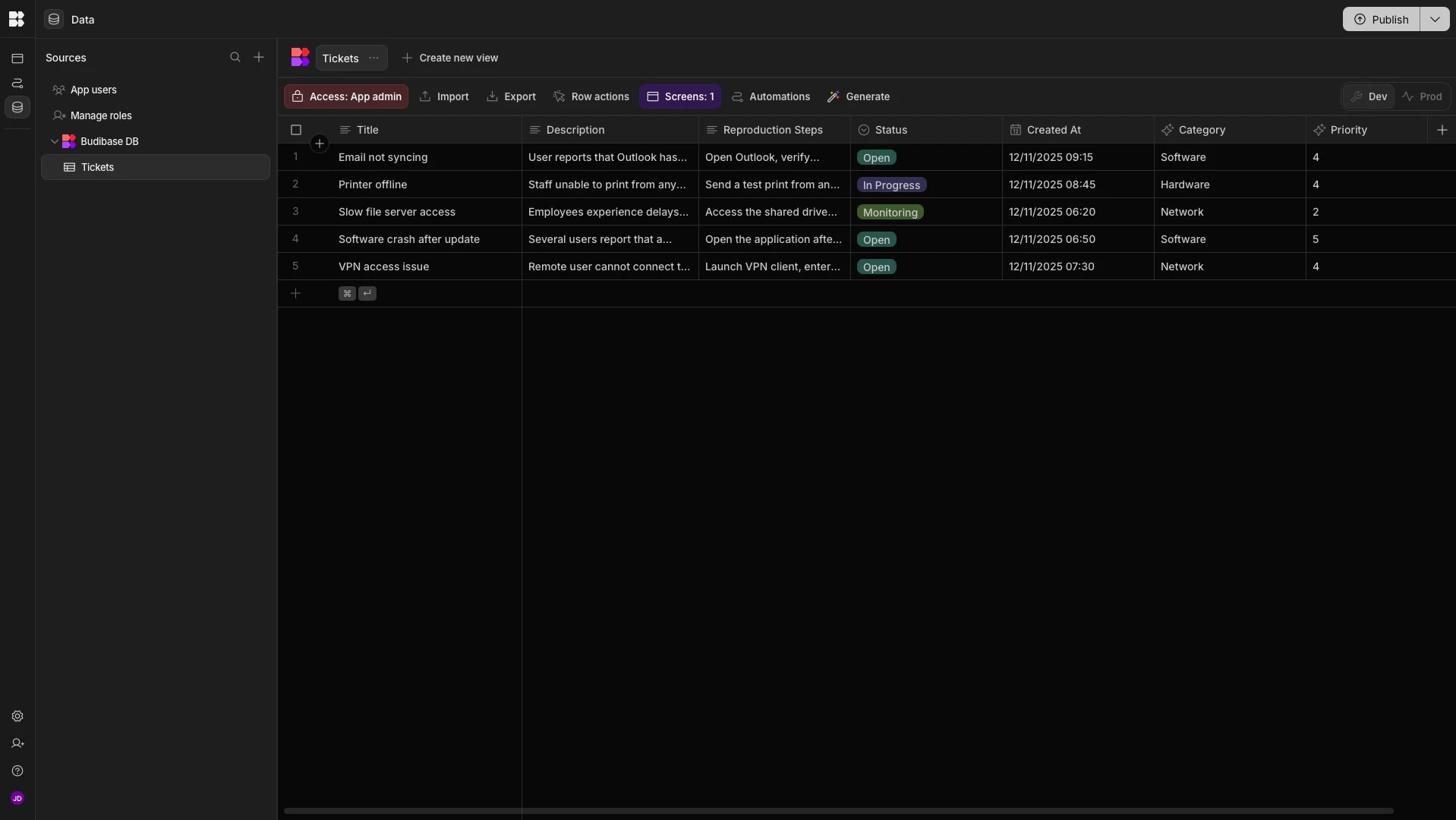
Now, when a user submits a ticket using our form, it will be fully triaged with AI, including having an appropriate category and priority level assigned.
Turn data into action with Budibase
Budibase is the open-source, low-code platform that empowers IT teams to turn data into action.
With extensive support for external databases and APIs, autogenerated UIs, powerful AI-driven automations, custom RBAC, optional self-hosting, and more, there’s never been a better way to build modern, secure workflow tools.
Take a look at our features overview to learn more.